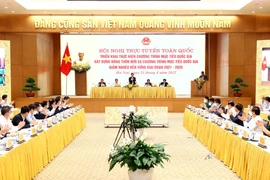Hanoi (VNA) - Minister of Agriculture and Rural Development Le Minh Hoan on October 3 chaired a conference reviewing the Science and Technology Programme for New Rural Development in the 2016-2021 period and plans for the next five years, during which he affirmed science and technology create new vitality for rural areas.
Agricultural land could be narrowed as more land and resources would be used for other industrial and infrastructure projects, he said.
“The productivity of agricultural areas will eventually reach its limit. If itis not possible to increase productivity and output, there is no other way butto increase the value of agricultural products,” he said.
To promote the implementation of the National Target Programme on BuildingNew-style Rural Areas, the Prime Minister approved the Science and TechnologyProgramme in early 2017.
The programme is implemented continuously with the first phase starting from2016 to 2020 and the second phase from 2021 to 2025.
Under the programme’s second phase, 84 science and technology tasks wereidentified to serve the National Target Programme on Building New-style RuralAreas in five major content groups with a total implementation cost of nearly 586billion VND.
Science and technology played a crucial role in agricultural production and newrural area construction, Hoan said, emphasising that the science and technologyprogramme must go in line with Central Party Committee's resolution No.19-NQ/TW, dated June 16, 2022 on agriculture, farmers and rural areas to 2030with a vision to 2045 to transform agricultural production thinking intoagricultural economic thinking.
“Each scientific research project for the construction of new rural areas notonly focuses on technical factors, but also needs to increase the content ofknowledge along with agricultural economic factors and market factors tooptimise the value of agricultural products and reduce production costs,” Hoansaid.
"Scientists not only transferred science and technology models to farmers,but also opportunities to help farmers improve their knowledge, increaseproductivity, and create new momentum for agriculture and rural areas."
The science and technology programme helped tighten the connection of resourcesbetween the sciences, theory and practice, and research and transfer to meetthe requirements of the development of new-style rural areas, Hoan said.
Prof. Dr. Nguyen Tuan Anh, Programme Manager, said the programme contributed topromoting the development of commodity agriculture, connected and modernagriculture, and ecological and sustainable agriculture.
He said it also helped boost supporting industries for agriculture; economicrestructuring, and rural labour.
The programme created many practical scientific products, many models oftransfer and application of technical and technological advances toagricultural production, he said.
Over the last five years, under the programme, 97 production processes andtechnologies were transferred, and 208 effective demonstration models wereconducted.
“In cultivation, the programme generated results that helped increase cropproductivity by 30-35% for vegetables, 10-15% for rice, and increased the incomeof participants by over 25%,” he said.
Thanks to the restructuring of farming in production linkage models, the valueof agricultural land use reached 133-500 million VND per ha per year, Prof. Dr.Tuan Anh said.
In animal husbandry, high-yield and high-quality breeds were used widely,including pigs, chickens and geese.
In addition, typical factors that increased economic efficiency with differentlevels contributed to total additional productivity, such as changing cropstructure contributed 12.1%; integrated disease management (IPM) 15%;irrigation 35-40%; new plant varieties 25-30%; new livestock breeds contributed16.8%; while fertilisers and other technical measures contributed 25-30%.
Vu Thi Van Phuong, representative of VietRAP Investment and Trade Joint StockCompany, said that from scientific research, the company organised links withpeople in many northern mountainous regions to apply and effectively useresources under the forest canopy.
Science and technology were applied to ensure rational cultivation of medicinalplants that are used to make commodities with higher economic values, she said./.





























